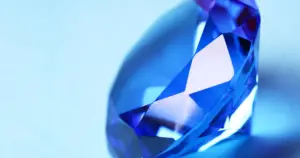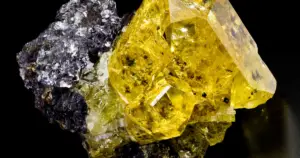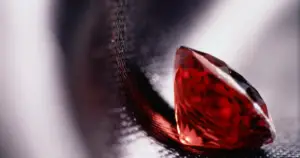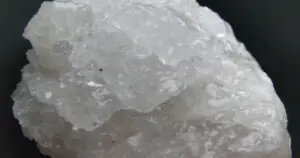Scapolite Meaning: Healing Properties, Benefits and Uses

Scapolites are aluminosilicates. Meionite, marialite, and silvialite are among the aluminosilicate minerals referred to as Scapolite. The final members of a solid solution series are meionite and marialite. Meionite and the mineral silvialite are quite similar.
These minerals’ chemical composition, crystal forms, and physical characteristics are strikingly similar. In the wild or when examining hand specimens in a lab, it is difficult to tell them apart from one another. Scapolite is the name of a phrase for simple communication.

Table of Contents
What is Scapolite?
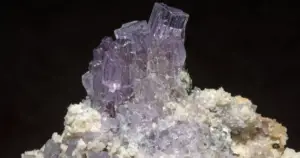
Scapolite resembles various feldspars in appearance quite much. It is very simple to overlook in the field and while examining hand specimens in a laboratory. These large examples frequently have a fibrous or wood-grain structure, which makes it easier to identify them. Scapolite frequently occurs as full or partial replacements of the feldspar grains in metamorphosed igneous rocks, particularly gabbro and basalt.
Scapolite crystals can occasionally be found in pegmatites and rocks that have undergone contact metamorphism. These minerals are typically found where impure limestones have crystallized as a result of contact with igneous magma because they are calcium-rich silicates. At the points where intrusive masses and limestone meet, scapolite and wernerite are much more prevalent.
The scapolites are usually practically black due to the presence of extremely minute enclosures of graphitic material, although they can also be colorless, flesh-colored, grey, or greenish. The tetragonal cleavage, high double refraction, and uniaxial interference figure easily differentiate them from other minerals even though they are not in particularly flawless crystals, but occasionally incomplete octagonal sections are visible.
They typically weather to form micaceous aggregate, but occasionally they are replaced by an unknown isotropic material. In crystalline limestones and calc-silicate rocks, they appear as tiny, typically undetectable grains incorporated into the rock’s other elements. Sometimes, argillaceous rocks (altered calcareous shales) that have undergone thermal metamorphism include large, virtually idiomorphic crystals.
How to identify a Scapolite?
Golden topaz, golden beryl, chrysoberyl, and tourmaline are gem types that are frequently confused with scapolite, however, these gem types are significantly harder than scapolite. Scapolite is frequently quickly detected with a straightforward hardness test. It can be challenging to distinguish a cat’s eye scapolite from other chatoyant gemstones, but it has very distinct and visible “eyes.” Diopside and chrysolite are sometimes referred to as olivine or peridot, and scapolite is a related mineral.
Scapolite is typically facetted using a number of shapes and cut methods, including oval, round, cushion, rectangular, trillion, pear, and other fancy shapes. Large premiums may be charged for calibrated sizes. Very huge proportions of scapolite are frequently discovered. In actuality, most scapolite gemstones weigh more than 6 carats. As with rainbow scapolite gems, translucent materials are frequently cut en cabochon to enhance their chatoyancy.
Scapolite Cuts
It can be found in various crystal shapes, including rectangular or square cuts, rounds, pears, ovals, emeralds, cushions, and many others. The more transparent stones are faceted, while the less transparent stones may be cabbed to produce some cat-eye stones.
Pink and violet scapolite has a lovely cat’s eye effect and is sometimes mislabeled as “pink moonstone.” Cut from opaque Quebec and Ontario materials, cabochons are particularly attractive and frequently glow. Golden scapolite from Tanzania such as the one below is both cleaner and darker in tone than that from Brazil.
Additionally, there are sufficient quantities to make jewelry promotion practical. The color of this round, Portuguese-cut scapolite from Sri Lanka, weighing 14.41 carats, changes from brownish yellow to orange when exposed to longwave UV light.
Scapolite Shapes
Scapolites come in various shapes that include cat’s eye, oval, square, and rectangle. Transparent scapolite in shades of yellow and pink can be carved into enticing gems like the yellow scapolite on this page. Some examples have minute fiber inclusions that cause the stone to become “silk,” which reflects light to create a cat’s-eye pattern.
Where is Scapolite Found?
The scapolite crystals naturally divide into four groups based on their origin.
- The contact metamorphic rocks and scapolite limestones. These minerals are typically found where impure limestones have crystallized as a result of contact with igneous magma because they are calcium-rich silicates. Even meionite, the variation with the highest soda content, is found in this relationship; it is primarily found in the tiny crystals lining the crevices of crystalline limestone blocks ejected from Vesuvius and the craters of the Eifel in Germany. At the points where intrusive masses and limestone meet, scapolite and wernerite are much more prevalent.
- Scapolite often replaces feldspar in mafic igneous rocks like gabbro and diabase through a secondary or metasomatized process. When viewed under a microscope, some Norwegian scapolite-gabbros (or diorite) provide instances of each phase of the process. Minor chemical alterations are made, with the assumption of a trace quantity of chlorine in the new molecule being among the most significant. It is common to observe the scapolite replacing some of the feldspars while leaving other areas unchanged and fresh. The process mimics metamorphism rather than weathering since the feldspar does not weather but instead stays fresh.
- In Norway, Oedegrden and other sites have long been noted for their scapolite-hornblende rocks. They have been referred to as spotted gabbros, however, they often do not contain feldspar; instead, the black matrix surrounding them is made up of an accumulation of green or brownish hornblende, while the white spots are scapolite. They are very similar to the Pyrenean scapolitized ophites in many ways.
- Scapolite is a key component of many metamorphic rocks with gneissose characteristics that are found around the world. Their origin is frequently a mystery, although it’s likely that there are two different types. One series is essentially igneous (orthogneisses); typical constituents include the light green color of pyroxene, feldspar, sphene, and iron oxides in varying amounts. Quartz, rutile, green hornblende, and biotite are regularly encountered; hypersthene is less prevalent. Garnet appears on occasion. They coexist with different types of pyroxene gneiss, hornblende gneiss, amphibolites, etc.
Scapolite in gem quality is extremely uncommon, yet it can be discovered in a few places across the world. Tanzania is regarded as having the best production standards. Among the more significant providers are Brazil, Burma (Myanmar), Canada, Italy, Kenya, Madagascar, Mexico, Namibia, Norway, and the United States. A mottled variant of scapolite that is closely related to diopside is well-known in Canada. Despite being opaque, the substance produces an intriguing gemstone when cut into a cabochon thanks to the mottled pattern.
Quebec and Ontario in Canada, Kiruna in Sweden, Pennsylvania in the United States, and Queensland in Australia are the main locations for occurrences. These minerals are part of a solid-solution (chemical replacement) sequence in which the molecules of sodium and calcium swap places. The sodium aluminosilicate marialite and the calcium aluminosilicate meionite are the theoretical end-members (pure compounds). Despite being synthesized, they only occur naturally when at least 20% of one is substituted for the other.
Scapolite Stone Meaning
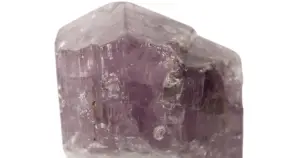
Scapolite gets its name from the shape of its long prismatic, columnar crystals (Greek skopos = rod, lithos = stone).
It is a common mineral that can form rocks. It is formed by pneumatolytic processes in volcanic rock cavities, and more commonly in metamorphic rocks by magma contact metasomatic action on dolomite and limestone.
Scapolite Meaning in Ancient Lore and History
Scapolite is a rare gemstone named after the Greek word “skapos,” which means “stick or stem,” because of its long columnar crystal formation. However, it can also be violet, orange, pink, brown, grey, or colorless. Scapolite is typically honey-yellow. Due to its brilliance and vitreous luster, it is a sought-after gemstone and collector’s item. Another name for scapolite is “wernerite,” after its discoverer. Scapolite is also known by the names mizzonite, dipyre, marialite, and meionite.
Scapolite is a fine-quality gemstone incredibly uncommon and highly sought-after mineral collected by gem and mineral enthusiasts Scapolite is considered a “lesser-known” gemstone because of the scarcity of transparent gem-quality material.
It is a collector’s stone since it lacks the hardness and durability needed for the majority of common jewelry uses. Cat’s-eye or chatoyancy effects can sometimes be seen in scapolite. Cat’s eye scapolite is a very uncommon and expensive mineral. The unusual “rainbow scapolite” form of scapolite includes iridescent inclusions.
Northern Burma (Myanmar) is where scapolite, in the form of fibrous white, pink, and violet crystals, was first found in 1913. In 1920, yellow scapolite was discovered in Madagascar; ten years later, it was found in Brazil.Following those discoveries in Mozambique
Tanzania and Kenya Petchite is a purple variety of scapolite discovered in Tanzania in 1975.
Even though gem-quality scapolite is incredibly rare, it can be found in a number of places around the world. The best materials are thought to be produced in Tanzania. Among the other important suppliers are Brazil, Burma (Myanmar), Canada, Italy, Kenya, Madagascar, Mexico, Namibia, Norway, and the United States. Canada is well-known for its mottled scapolite, which is closely associated with diopside. Despite being opaque, the material has a mottled pattern that makes it a unique cabochon gemstone.
Scapolite Crystal Properties
Scapolite appears to be very similar to many feldspars. As a result, it is easily overlooked in the field and during laboratory hand specimen examination.
Massive of this crystal can be found in metamorphosed rocks like marble, gneiss, and schist. These massive specimens frequently have a wood-grain or fibrous texture that aids in their verification. A well-formed, gem-quality prismatic crystal with a square cross-section can be found in marbles.
Scapolite is frequently found as a kind of replacement for feldspar grains in metamorphosed igneous rocks, particularly gabbro, and basalt. Pegmatites and rocks changed by contact metamorphism are both sources of scapolite crystals.
Scapolite minerals are severely damaged by weathering. They easily change into micas and clay minerals and are among the first minerals to be attacked in their host rocks. As weathering progresses, the mineral grains lose transparency, become opaque, and lose hardness.
Scapolite Healing Properties

- Powerful energies carried by scapolite can improve your physical and mental well-being and help treat particular physical and mental conditions.
- It can provide the body with vibrant energies that act as antioxidants at the cellular level.
- It can also be used to treat the arteries and veins in conjunction with crystals for confidence.
- You might benefit from scapolite energies if you suffer from head, neck, shoulder, or upper chest pain.
- The liver, bladder, and reproductive organs can benefit from the stone’s potent moving energies.
- It is known to be an effective PMS treatment. Scapolite can help with circulatory and digestive system functions. Additionally, it helps lower blood pressure and de-stress.
Scapolite Metaphysical Properties
According to esotericists, scapolite’s magical abilities are derived from its color. Blue stones help with concentration and determination. It will become their closest ally if they have a goal and are prepared to put forth the necessary effort to achieve it. If you want to get in shape, save money, or finish college, you can rely on such a talisman.
It is advised to remember that it will not work for you. Instead, it will assist you in making the most of your efforts while also removing distractions. Scapolite is known as the student’s stone because it favors people who must absorb and process large amounts of information.
Yellow scapolites can aid in the organization of your finances. They do not guarantee prosperity, but they can help you improve your spending habits and identify good money-making opportunities. This particular kind of scapolite, like other warm-colored stones, is linked to the sun and its power.It will comfort you, keep you warm, and give you the willpower to get through hardship.
Scapolite is a protective talisman that can also be used for meditation. The stone draws happiness, good health, and with its owner’s intuition
Scapolite Benefits
Scapolite can be used to balance out inattentiveness and hyperactivity. It promotes assimilation, evacuation, and digestion. Disorders of the kidney or gallbladder can benefit from scapolite. It helps with bone and arthritis issues and may lessen dementia and Alzheimer’s disease side effects.
Scapolite will help keep the veins and arteries in good condition. controls blood circulation and excessive blood pressure. It will aid in reducing the physical signs and symptoms of neurological breakdown. reduces the discomfort and swelling brought on by tense shoulders and neck. enhances the recovery from glandular fever, mononucleosis, and infections of the glands. aids in reducing the symptoms of Hodgkin’s lymphoma, tension headaches brought on by toothaches, gingivitis, and recurrent ear infections.
Scapolites will assist you in figuring out what your life’s significance is and why you’re here. All of your chakras will be in harmony as a result, allowing for a healthy flow of energy. You can have more sound decision-making when there’s no obstruction in your energy flow, especially when it comes to decisions involving love and your emotions.
During stressful situations, scapolite will assist you to relax and help you become more logical. This stone will guarantee your mental equilibrium. It’s also a great meditation stone because it helps clear the mind of pointless worries and ideas. It will immediately increase your attention and vibrations. Scapolite can assist you in overcoming your obstacles and remaining unaffected by them.
Scapolite Benefits Spirituality
- It provides a sense of relief when you are feeling burdened. It brings about positive change and aids in the recovery from past trauma.
- Scapolite is advantageous for problem-solving and rational application. It instills a sense of practicality and keeps you grounded in reality.
- Scapolite tumbled stones will assist you in quickly and easily achieving a meditative state.
- They will also raise your psychical awareness, allowing you to explore higher spiritual realms.
- Scapolite tumbled stones in grey, white, or purple resonate with the crown chakra, stimulating physical awareness and communication with the spiritual realm.
- Scapolite will help you get rid of things, routines, viewpoints, and actions that are no longer good for your health.
- By curing you of your ailments on a physical, emotional, mental, and spiritual level, you will become more centred and at peace.
Scapolite & Feng Shui
- Feng shui is a technique that ties our dwellings to the cycles of nature. By introducing pictures and symbols of natural objects, such as trees, we can introduce a touch of nature into our living spaces.
- Gem trees, commonly referred to as crystal trees, are ornamental items that resemble miniature trees. They are constructed of gold or copper-colored metal wire with leaves made of semi-precious stones or crystals.
- Because they are made of precious elements like crystals, gem trees are intrinsically valuable. Additionally, they have a jade plant shape, which can be a symbol of luck and fortune.
- Due to their energizing qualities and the current craze for natural crystals, many practitioners today prefer to employ them as feng shui artifacts. Crystals are lovely objects that you can utilize in your home with feng shui aims if they speak to you.
- Scapolites appear in this regard as an instrument of performing Feng Shui as they have several physical, spiritual and metaphysical qualities. Scapolites are one of the most preferred varieties of chrystals that are used in Feng Shui.
Scapolite Birthstone
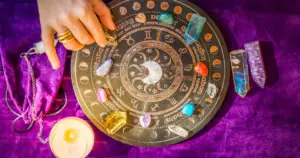
Given that scapolite is not a very well-known gemstone, it lacks the legends, mythology, and myths that many other gemstones have. It is not a recognized birthstone, nor does it serve any planetary or zodiac functions. However, it still carries a powerful energy that will help with both mental and physical ailments. This is because there are so many different colours available. In general, this crystal can assist you in resolving all problems. This is why scapolite is regarded as a stone that solves difficulties. It is also a symbol of success.
Scapolite Chakras
The chakras are the internal energy centers of the body that are aligned vertically near the spine. Energy enters the body (earth) at the base (earth) and the head (heaven). These forces meet at the vortex points of the seven chakras, creating a special energy pattern. These chakras take in, modify, and disperse the body’s own energy as well known as prana, vital energy, or chi. Each chakra has corresponding emotional, behavioral, and personality patterns as well as specific body organs and parts.
According to conventional Hindu cosmology, scapolite is believed to regulate the flow of energy in the lower chakras as well as in Anahata, or the heart chakra, which controls judgment, emotions, and love. Scapolite is thought to aid in the treatment of glaucoma and cataracts. It is also thought to help with shoulder, neck, head, and upper chest pain. Crystal healing jewelry uses scapolite with magnetite inclusions and a rainbow hue. Some people think that the magnetic mineral magnetite, a member of the spinel group, has advantageous magnetic properties.
What are the Uses of Scapolite?
- A gemstone called scapolite is renowned for its capacity to solve issues. It will assist you in resolving both past and current issues.
- Additionally, it is a symbol of success that might encourage you to accomplish all of your objectives.
- It will assist you in discovering your life’s meaning and purpose in this world.
- All of your chakras will be balanced as a result, promoting a smooth flow of energy. When your energy flow is unobstructed, you can make more sound decisions, especially when it comes to love and emotions.
- During stressful situations, Scapolite will help you relax and become more rational. This stone will maintain your mental equilibrium.
- It also makes a great meditation stone because it helps to clear the mind of unwanted ideas and concerns. It will immediately raise your vibrations and focus.
- Scapolite can help you overcome your obstacles and stop letting them intimidate you. It will improve your self-awareness and prevent you from misusing your power.
- Scapolite can aid in the transformation of your life and environment. This stone will assist you in getting to where you need to go to achieve your objectives.
- Positive feeding energies in scapolite do not deplete or fatigue you.
- Scapolite is a powerful stone that offers psychic protection.
- It will improve your psychical awareness as well as your telepathic abilities.
- It will raise your consciousness, allowing you to receive higher guidance.
- Scapolite will connect with your chakras, allowing you to communicate with higher dimensions.
- It will also improve your visionary experiences, allowing you to think clearly and move forward in life with confidence.
Caring for Scapolite
Scapolites, with a hardness of 5.5 to 6 and perfect cleavage, require caution when setting and wearing as jewelry. Although it is not advised to wear rings as ring stones every day, protective settings and occasional use will allow you to display these seldom-seen jewels. Scapolites would make wonderful pendants and earrings.
Avoid using mechanical systems to clean scapolites. Rather, you should only use a soft brush, mild detergent, and warm water.
When to Cleanse Scapolite?
The best way to clean scapolite gemstones is with soapy water and a soft cloth. Rinse thoroughly to remove any soapy residue. Avoid exposing scapolite to sudden temperature changes. Ultrasonic cleaners and steamers, like most gemstones, are not recommended. Always take off any jewelry or gemstones before exercising, cleaning, or partaking in strenuous physical activities like sports. Keep apolite away from other gemstones as it is easily scratched by harder materials.
How to Recharge Your Scapolite?
Using the Sun to Charge Crystals
The power of the sun will benefit all crystals and stones.
The energy of the sun is yellow, and everything
You must take action to purify and recharge your
Stones and crystals should be exposed to the sun.
for a few, possibly seven, hours
It is up to you how long you expose your crystals and stones to the sun. I recommend at least 24 hours to achieve good results.
Just remember to bring them inside when the sun goes down.
Using Moonlight to Charge Crystals
You can cleanse and charge your crystals and stones by placing them under the light of a full or crescent moon.
Make sure that your crystals and stones are only exposed to moonlight when cleansing and charging them with solar power.
If there is no access to natural water, you can make a saltwater solution with tap water and a pinch of salt. Use caution while doing this method of washing and charging as salt is abrasive and can harm stones and crystals with softer characteristics.
Scapolite Activation process
Scapolite is a potent stone of freedom, liberation, and self-transformation, assisting us in letting go of old patterns that no longer serve our highest good and embracing new ones.
Scapolite, a stone of perseverance, provides self-discipline and willpower to help us persevere until our goals are met. This stone provides us with knowledge and the ability to communicate with guides and angelic beings.
Scapolite comes in a variety of colors, each with a distinct focus. All seven Chakras can be opened, activated, and healed with this stone.
How much is Scapolite worth?
The cost of natural scapolite may vary significantly depending on the size and quality of the gemstone. However, the price can range anywhere from as low as $24 to as high as $200.
What determines Scapolite’s price and value?
The price of scapolite is determined by its size, shape, color, and cut. For example, a colorless venerate of 1carat can cost as little as $25 while the price of a rare light blue/ violet or even very slightly greyish scapolite can be as high as $150.
Scapolite Impact
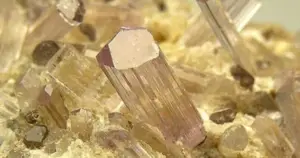
The scapolite is a stone that is well-known for its problem-solving energies. You could also be able to solve every issue with its aid. Because it may inspire and motivate you to achieve your goals, this stone is also known as the stone of achievement.
Furthermore, this may assist you in discovering your life’s meaning as well as your purpose in this world. It will also help to balance all of your chakras, allowing for a smooth energy flow.
In times of stress, the scapolite may also help you to relax and become more rational. Scapolite might keep you mentally balanced. Not only that, but this is an excellent meditation stone because it can help to eliminate unnecessary worries and thoughts. Additionally, it might immediately sharpen your focus and vibrations.
Additionally, this stone could help you overcome your obstacles rather than letting them demoralise you. In order to avoid abusing your power, it will also help you better understand who you are. It might also help you get where you need to go to accomplish your goals.
Does Scapolite make a good jewelry stone?
Scapolite would be an appealing gem material for both jewelry and mineral collectors.It boasts a vibrant fluorescence and a range of hues. Rare specimens also exhibit incredible effects such as chatoyancy. Tanzanian golden scapolite has a darker tone and is cleaner than Brazilian material. Furthermore, there is enough to make jewelry promotion feasible.
Scapolite Real vs Fake
An average person can’t differentiate between a real and fake Scapolite under normal circumstances. Even for most gemologists, it is a difficult and demanding task. Yet, like other minerals, scapolites are also susceptible to being faked owing to the huge amount of money that there is in such trade. Even though an expert may be able to differentiate between real and fake scapolite by the differences in color and size, fake ones being slightly smaller or deformed, the only real way to identify fake scapolite is to examine it under a microscope.
FAQs
What is Scapolite used for?
The scapolite is a stone that is well-known for its problem-solving energies. It could also enable you to resolve every issue. Because it may inspire and motivate you to achieve your goals, because it may inspire and motivate you to achieve your goals because it may inspire and motivate you to achieve your goals, this stone is also known as the stone of achievement.
How is Scapolite formed?
Scapolite crystals can be found in pegmatites and metamorphic rocks such as mica schist and gneiss. Scapolite can also be found in massive quantities. Brazil, Burma, Canada, Kenya, and Madagascar are among the countries represented. Some pink and purple stones have a cat’s-eye effect. Scapolite is easily mistaken for amblygonite, chrysoberyl, and golden beryl. When parallel needle-like inclusions are found within scapolite, it is cut into a cabochon; otherwise, it is cut into a facetted cut stone. Kenya, Madagascar, Brazil, and Tanzania produce the best scapolite.
Where should I put Scapolite?
Avoid exposing scapolite to sudden temperature changes. Ultrasonic cleaners and steamers, like most gemstones, are not recommended. Always take off any jewelry or gemstones before exercising, cleaning, or partaking in strenuous physical activities like sports.
How do you cleanse Scapolite?
Rinse or soak scapolite in clear water to clean it (no salt). This is more for removing dust, dirt, and fingerprints before gently drying with a cloth or paper towel.
Is Scapolite rare?
A typical form of scapolite, which is a common mineral, is opaque and unattractive. However, this material can be found in clear gemmy forms in a few exceptional sites, which creates a valuable and attractive gem. Scapolite’s very low hardness has prevented it from becoming a more popular gemstone, despite its gorgeous colors.
How strong is Scapolite?
It has a Mohs hardness of 5 to 6, making it soft to be used as a ring stone.
How much is Scapolite worth?
Natural scapolite prices can vary significantly depending on the size and quality of the gemstone. However, it is possible to pay as little as $24 or as much as $200 for the item. The size, shape, color, and cut of scapolite all affect its cost. For instance, the price of a rare pale blue/violet or even very slightly greyish scapolite can go as high as $150. A colorless venerate of 1 carat can cost as low as $25.
How do you identify Scapolite?
Massive of this crystal can be found in metamorphosed rocks like marble, gneiss, and schist. These massive specimens frequently have a wood-grain or fibrous texture that aids in their verification.
